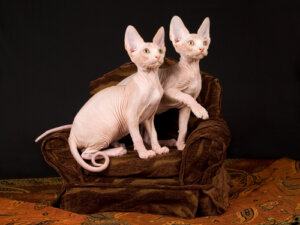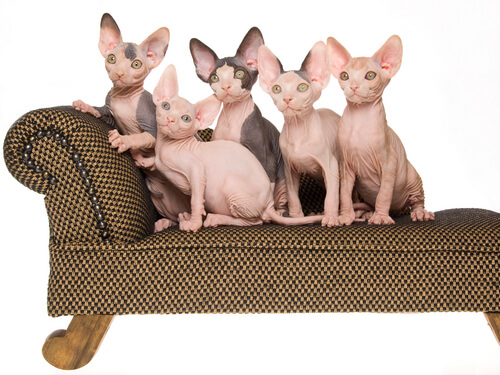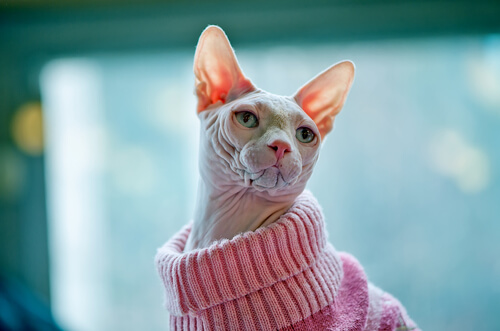Sphynx Cat: Character, Diet, and Care

The Sphynx cat is a feline that truly breaks all the molds of the feline world. In addition to having a different physiology, its personality is more similar to a dog’s than a cat’s. In fact, this Egyptian cat was the inspiration for Steven Spielberg to create his most famous movie character, E.T.
Where does the Sphynx cat come from?
The specific origin of this breed is unknown, although hairless cats in effigy form have been recorded on Egyptian and pre-Columbian clay pots. However, this current breed is very much from the 20th century. Appearances of hairless felines have been documented since 1960, but it wasn’t until 1966 that people began to breed them.
In fact, this species of feline breed is still in its infancy, and there are only about 60 in existence worldwide. This number is due to the fact that valid subjects for breeding aren’t always easy to find.
The physical appearance of the Sphynx cat
The most striking feature of this breed is its lack of hair. This characteristic doesn’t imply any disadvantages compared to other felines, although the sensation it causes to the touch is very different. Its skin is soft and its internal body temperature is high, as it doesn’t have a coat to insulate it from the cold.

The Sphynx is a medium-sized, healthy, robust, and muscular cat. Its ears are very large and its eyes are ellipse-shaped, like a lemon. It has a prominent, rounded belly, and the fact that it has wrinkles doesn’t mean that it’s old! Moreover, wrinkles in this breed are highly valued, especially if they’re around the muzzle, between the ears, around the shoulders, and on the neck.
Character
This cat, unlike most felines, is very affectionate and tireless, and constantly seeks cuddles from its owners. This breed is unlike other cats in that it mixes characteristics of apes, canids, and felines.
The sphinx cat is affectionate, intelligent, playful, and very dependent. If there’s one thing it can’t stand, it is living alone. Many times it has been described as a very lively and active little clown.
What does the Sphynx cat eat?
This animal’s diet must be balanced, very nutritious and, above all, rich in fats, as, because it doesn’t have any hair, it needs to burn a lot of calories to maintain its body temperature. This cat loves to eat and is always ready to eat anything, so it’s advisable to watch its diet and not to offer it human food, as this can harm it.
The best food for the sphinx cat is quality cat food. Cat food, over time, has evolved positively thanks to scientific and veterinary research. On the market there are different types of preparations, manufactured according to the animal’s physiological condition, and even include special food for the prevention or cure of feline diseases.

In fact, there’s even specific food on the market for the Sphynx, made from processed products that meet its needs. If you prefer to give it a more generic type of food, made for any breed, then you should ensure that it’s of high quality. In addition, you should keep in mind that, as this breed of cat eats more than other breeds, you will need to provide bigger portions.
In addition to this, you’ll need to supplement dry food with wet or semi-moist food. Finally, it’s very important that you always ensure the cat has clean, fresh water at its disposal, which will help to cover its water needs.
What special care should be given to the Sphynx?
Finally, we need to mention some special care that should be given to the Sphynx cat. Its high-calorie diet produces more grease on its skin and more wax in its ears, and so it’s advisable to clean its ears regularly with wipes. In addition, even though it’s hairless, hygiene is just as important for this cat as it is for other felines.
This is why they should be bathed weekly in summer and monthly in winter. The shampoos and soaps that you should use with this cat must be soft and dermo protective. The reason for this is that they don’t have any hair to protect them from any damaging effects of unsuitable products on the skin.
We hope you’ve enjoyed this insight into a most fascinating cat, and maybe we’ve tempted you to adopt one!
The Sphynx cat is a feline that truly breaks all the molds of the feline world. In addition to having a different physiology, its personality is more similar to a dog’s than a cat’s. In fact, this Egyptian cat was the inspiration for Steven Spielberg to create his most famous movie character, E.T.
Where does the Sphynx cat come from?
The specific origin of this breed is unknown, although hairless cats in effigy form have been recorded on Egyptian and pre-Columbian clay pots. However, this current breed is very much from the 20th century. Appearances of hairless felines have been documented since 1960, but it wasn’t until 1966 that people began to breed them.
In fact, this species of feline breed is still in its infancy, and there are only about 60 in existence worldwide. This number is due to the fact that valid subjects for breeding aren’t always easy to find.
The physical appearance of the Sphynx cat
The most striking feature of this breed is its lack of hair. This characteristic doesn’t imply any disadvantages compared to other felines, although the sensation it causes to the touch is very different. Its skin is soft and its internal body temperature is high, as it doesn’t have a coat to insulate it from the cold.

The Sphynx is a medium-sized, healthy, robust, and muscular cat. Its ears are very large and its eyes are ellipse-shaped, like a lemon. It has a prominent, rounded belly, and the fact that it has wrinkles doesn’t mean that it’s old! Moreover, wrinkles in this breed are highly valued, especially if they’re around the muzzle, between the ears, around the shoulders, and on the neck.
Character
This cat, unlike most felines, is very affectionate and tireless, and constantly seeks cuddles from its owners. This breed is unlike other cats in that it mixes characteristics of apes, canids, and felines.
The sphinx cat is affectionate, intelligent, playful, and very dependent. If there’s one thing it can’t stand, it is living alone. Many times it has been described as a very lively and active little clown.
What does the Sphynx cat eat?
This animal’s diet must be balanced, very nutritious and, above all, rich in fats, as, because it doesn’t have any hair, it needs to burn a lot of calories to maintain its body temperature. This cat loves to eat and is always ready to eat anything, so it’s advisable to watch its diet and not to offer it human food, as this can harm it.
The best food for the sphinx cat is quality cat food. Cat food, over time, has evolved positively thanks to scientific and veterinary research. On the market there are different types of preparations, manufactured according to the animal’s physiological condition, and even include special food for the prevention or cure of feline diseases.

In fact, there’s even specific food on the market for the Sphynx, made from processed products that meet its needs. If you prefer to give it a more generic type of food, made for any breed, then you should ensure that it’s of high quality. In addition, you should keep in mind that, as this breed of cat eats more than other breeds, you will need to provide bigger portions.
In addition to this, you’ll need to supplement dry food with wet or semi-moist food. Finally, it’s very important that you always ensure the cat has clean, fresh water at its disposal, which will help to cover its water needs.
What special care should be given to the Sphynx?
Finally, we need to mention some special care that should be given to the Sphynx cat. Its high-calorie diet produces more grease on its skin and more wax in its ears, and so it’s advisable to clean its ears regularly with wipes. In addition, even though it’s hairless, hygiene is just as important for this cat as it is for other felines.
This is why they should be bathed weekly in summer and monthly in winter. The shampoos and soaps that you should use with this cat must be soft and dermo protective. The reason for this is that they don’t have any hair to protect them from any damaging effects of unsuitable products on the skin.
We hope you’ve enjoyed this insight into a most fascinating cat, and maybe we’ve tempted you to adopt one!
This text is provided for informational purposes only and does not replace consultation with a professional. If in doubt, consult your specialist.








